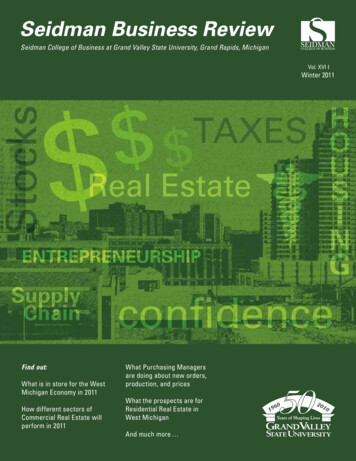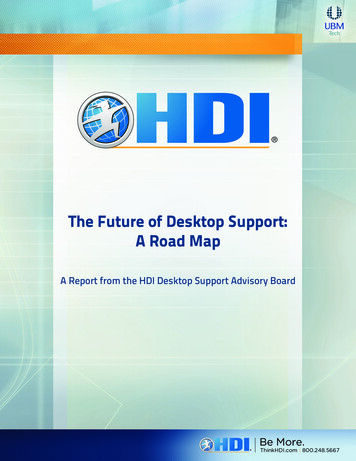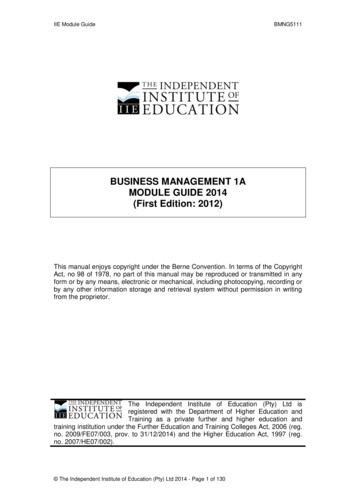
Transcription
Seidman College of Business at Grand Valley State University, Grand Rapids, MichiganVol. XVI IWinter 2011Find out:What is in store for the WestMichigan Economy in 2011How different sectors ofCommercial Real Estate willperform in 2011What Purchasing Managersare doing about new orders,production, and pricesWhat the prospects are forResidential Real Estate inWest MichiganAnd much more
SeidmanBuSineSS ServiceS outreach to the Greater Grand RapidsBusiness CommunityBusiness Ethics Center616.331.7449 Business ethics roundtables Seminars and workshops Research Ethics courseworkFamily Owned Business Institute616.331.7200 www.fobi.gvsu.edu Research Family business resource center Family business courseworkInformation Services616.331.7370 www.gvbizinfo.com Demographic profiles of GR and Lakeshore Customized research services Market data/business related information Online commercial databasesMichigan Small Business & TechnologyDevelopment Center616.331.7370 www.www.misbtdc.org No-cost one-to-one business counsel Low-cost small business seminars Market research Referrals to business development resources Small business advocacyVan Andel Global Trade Center616.331.6811 www.vagtc.org International Trade Assessment International Market Research International Business Resources Import/Export Training and Counseling Chinese Language & Culture Service Trade Finance AssistancePartner in Outreach —U.S. Dept. of Commerce Export Assistance Center616.458.3564 Export counseling Trade finance assistance Conferences, seminars, and workshops Market research Export market representationSeidman Business Review is an annual publicationof Grand Valley State University’s Seidman College ofBusiness, Grand Rapids, Michigan.Educational OpportunitiesOffered by theSeidman College of BusinessBachelor of Business Administration (BBA) Accounting Business Economics —Emphasis in Real Estate Finance International Business Management—Emphases in general, human resources,operations, organizational information systems Marketing — Emphases in Distribution and Logistics and Professional Sales Supply Chain ManagementBachelor of Arts (BA) or Bachelor of Science (BS) in EconomicsMaster of Business Administration (MBA) Finance Emphasis General Health Sector Management emphasis Management of Innovation and Technology emphasisMaster of Science in Taxation (MST)Master of Science in Accounting (MSA)e-mail: gvbizinfo@gvsu.eduEditor:Dr. Hari Singh, Chair,Economics DepartmentCopy editors:Vonnie HerreraClaudia BajemaDesign and production:Ruth Oldenburg,Rainstick Studio Grand Valley State University, Seidman College of BusinessCertificate Program TaxationNon-Credit Certificate Programs Certified Financial Planning (CFP) NxLevel Entrepreneurial Program
From the Dean As we celebrate Grand Valley State University’s 50thAnniversary, we are proud and pleased to be able topresent this edition of the Seidman Business Review.Both the University and the College have been honored overthe years to serve this West Michigan business community.Moreover, in the mode of the classic servant-leader, theSeidman College has always felt a real responsibility fordischarging effectively its “regional commitment” missionimperative. Never has this charge been more critical thanduring this current economic climate.This edition of the Business Review continues theCollege’s commitment to keeping this community apprisedof important business results, challenges, opportunities,and innovations. While we must report some of the harshrealities of the economy for 2010, including slower-thanexpected recovery in some sectors of the economy, still-lowleasing of retail space, and the tight credit market for smalland mid-sized businesses, we are happy to report an increasein the confidence index (now above 50%), a positive “netabsorption rate” for industrial real estate, stabilizing rentalrates, cautious optimism reflected in the “production index,”another rise in the “local stocks index,” and an improving“home foreclosure” picture.As usual, the Review’s expert commentators provideWest Michigan economic and commercial real estateforecasts for 2011, a supply-management purchasingindex review and projections, and a performance reviewof West Michigan’s regional stocks. They also share specialperspectives on the Grand Rapids Housing Market and theeconomic prospects for Mixed Martial Arts (MMA) fightingentertainment in West Michigan. Finally, the Review provideskey articles addressing business and economic trends andissues, including the short-term economic impact of the2010 iteration of ArtPrize, another perspective on theentrepreneurial climate here in West Michigan, and howlocal Business Schools are responding to the issue of businessethics. I trust you will find this issue as informative as ever.As President Abraham Lincoln once observed, “There areno accidents. For every effect must have its cause. The past isthe cause of the present and the present will be the cause ofthe future.” As we celebrate 50 years as a University, caringabout, and sharing responsibilities with, this West MichiganCommunity, we take cognizance of— and acknowledge withgreat humility and thanks — the unparalleled support thiscommunity has provided this University and this College ofBusiness over many years. In large measure “that past” hascaused “this present.” Moreover, we know your continuedsupport will allow “this present” to cause a bright futurefor all of us — across this State and throughout the WestMichigan Community!May we all proceed with renewed vim and vigor towarda happy and productive 2011!!H. James WilliamsDean, Seidman College of BusinessSeidman Business Review Winter 2011 ContentsWEST MICHIGAN MARKET ANALYSIS25Grand Rapids Economic Forecast 2011Hari Singh, Ph.D., and Nancy Boese, M.B.A.The West Michigan economy has been in a process of consolidation, and weare at the end of the Great Recession of 2007–09. How is businessconfidence for 2011? What are the projections for employment and sales for2011? Find out what Grand Rapids area executives think.Commercial Real Estate Outlook for 2011Jeff L. Williams, Research Analyst West Michigan, Colliers InternationalThe commercial real estate market in Grand Rapids faces many challengesand opportunities. The retail, office, industrial, and investment markets arein different phases of the market cycle. Find out how different sectors ofcommercial real estate are faring in tough economic times.11 West Michigan Supply Management: A Year in ReviewBrian G. Long, Ph.D., C.P.M., Director, Supply Management ResearchThe manufacturing sector is witnessing structural changes andconsolidation. Is a significant turnaround in the works? Find out whatpurchase managers are saying about new orders, production, and prices.14 West Michigan Stock ReturnsGregg Dimkoff, Ph.D.The national stock market had a relatively good year in 2010. However,market volatility is quite significant. How did the regional stocks performcompared to the national market indices?16 Has the Grand Rapids Housing Market Bottomed Out?Paul Isely, Ph.D.The housing crisis was the genesis of the great recession, but there hasbeen no major bubble in the Grand Rapids housing market. Residentialhome prices, however, have been falling due to the recession. When willthe housing market find a bottom? What are the prospects for the future?BUSINESS ISSUES18 Business Schools and Business Ethics: Responibility and ResponseH. James Williams, Ph.D.This decade has been marked by all kinds of corporate scandals caused byunethical behavior. However, exactly what kind of behavior should beregarded as “unethical” is controversial, depending upon whose utility isbeing maximized: individual, corporation, or society? Should businessschools be blamed for these ethical lapses? What part of the problem canschools actually control and influence? Some key insights are provided byan education leader.22 The Fight for it AllAmber Brown, M.A.Struggling regional economies are trying to lure different types of sportsevents to their towns to encourage more economic growth. Legalized MixedMartial Arts (MMA) is one of the new trendy sports that is beginning toattract attention. Discover what kind of prospects this has for Michigan.24 The Economic Impact of ArtPrize 2010Jason O’Brien and Mike RizzoSenior Economics Majors at Seidman College of BusinessYou might have strolled around the City of Grand Rapids to view thedifferent exhibits during ArtPrize in the Fall. This contest is gainingreputation and interest from all over the world. As part of the economicscapstone course, students conducted a survey to determine the economicimpact of ArtPrize. The task was difficult because we had to discern thenet impact: the economic expenditures that we can solely attribute toArtPrize. Find out the estimated potential impact.26 Passing Entrepreneurship 101Stélios Alvarez, M.B.A., and Linda Chamberlain, Ph.D.In the new economy, entrepreneurship skills are at a premium. Many graduatesand job seekers may have to make their own jobs. West Michigan has toencourage and empower more entrepreneurs to embark on new projects thatcould create an expanding job market. How is the entrepreneurial climate inWest Michigan? See the grade list for different aspects of entrepreneurship.
Grand Rapids Economic Forecast 2011Hari Singh, Ph.D., and Nancy Boese, M.B.A.1Seidman College of Business Business confidence index is poised to rise significantly above 50% for the first time in 2 yearsA significant rebound in employment, expected growth is 2% in 2011Overall nominal sales are expected to grow by 2.5% for 2011Exports continue to be a bright spot; expected growth is 9% during 2011All indicators signal a significant turnaround in 2011Introductionhe survey for the greater Grand Rapids economy (Kent,Ottawa, Muskegon, and Allegan counties) was conductedin November 2010. A survey was mailed to the CEOs of937 organizations based on a representative sample. We triedto ensure that the sample represented different sectors of theregional economy and the geographical diversity of the area. Ofthe 937, 211 organizations responded, resulting in a responserate of 22.5%. Due to the small sample size, the survey should beinterpreted with caution.TA few methodological considerations are in order. Althoughwe discuss the survey results in terms of averages, the data arerepresented in a histogram format to show the entire distributionof responses. The employment, sales, and export numbers aremore volatile as raw averages (when calculated without adjustingfor outliers—responses beyond one standard deviation). Since100807083Confidence IndexA major goal of our survey is to historically track the overallbusiness confidence of the Grand Rapids metropolitan area by aConfidence Index. The Confidence Index respondents use a scalefrom zero percent (no confidence at all) to one hundred percent(complete confidence). Here are the average responses for theprivate sector and the government/non-profit sector over the last16 years (Figure 1). In response to the question: How confidentare you in the regional economy?West Michigan Confidence Index 2011Figure 190the average of a small sample is significantly influenced byextreme numbers, we use the averages without the outliers toprovide more reliable results. The histograms, however, depictall the available observations to show the broad picture. Notethat the total numbers in the histograms figures do not add upto exactly 211 because a few respondents did not provide theiremployment or sales 3.267.663.167.765.369.661.466.965.360.02 58.33575055.7755.2648.04 48.89 003DecDecDecDecDec20042005200620072008All Sectors (excluding Gov't /Non-Profit)Dec2009Dec Forecasted20102011Let us consider the privatesector confidence index.The current results need tobe interpreted in a largerhistorical context. Duringour surveys of the regionfor the last sixteen years,when the economy hasbeen growing steadily at arobust rate, the confidenceindex has depicted ahigh level of confidence,generally around 80% forthe private sector. Sincethe 2001 recession, theconfidence index hasbeen in the vicinity of thesixties and the high fifties.However, the confidenceindex during the last twoyears (December 2008 and2009) was below the 50%benchmark (approximately1 Hari Singh is a Professor of Economics in the Seidman College of Business at Grand Valley State University. Nancy Boese is the Business Tools Specialist of The Small Business &Technology Development Center (MI-SBTDC). We were aided by invaluable research support from Rennie Ramlal, graduate research assistant in the Economics Department.2Seidman Business Review Winter 2011
49%). In November 2010, the confidence index increasedto 55.26% It is projected to be higher at 59% for 2011. Thegovernment and nonprofit sector has similar numbers 53.96%for 2010 and 59.18% projected for 2011).about 0.3 of one percent. It appears that the forecasts havebeen quite accurate for the last two years.For 2011 employment is projected to grow at an average of2.3% in the private sector (without outliers). This is a significantincrease compared to last year. All the responses are depicted inFigure 2. We can see that the distribution is clustered in the 0 to2% range, but there are 40 respondents who expect to increasetheir workforce by more than 3%. Only 11 respondents expect toreduce their work force.Although we are beginning to come out of the Great Recession,expectations are still depressed but the overall outlook isbeginning to take a positive turn. For the first time in the lasttwo years the projected confidence is rising significantly abovethe 50% benchmark. There is a palpable increase in the regionalconfidence for the next year. The regional economy has pickedup its pace for the long consolidation process.Factors that continue to depress expectations for 2011 includethe continued tightening of credit to small business and thehigh unemployment rates. Consumer and business confidencewill consolidate slowly as the national economy improves. Thestructural problems in Michigan and the ongoing consolidationin manufacturing will continue to depress expectationssignificantly compared to the national profile.Last year 36% of the respondents indicated that they will hireworkers in 2010. This year approximately 60% have indicatedthat they will hire in 2011. Of the persons who responded, abouttwo thirds (66%) indicated that they would hire permanentworkers. These numbers corroborate the significant pickup inhiring that is expected to take place in 2011.Respondents’ Anticipated Change in Sales for 2011Respondents’ Anticipated Change in Employment for 201169Number of Responses706060504040293010030Number of Responses80802090(All Sectors)90(All Sectors)100704030Figure 20From1.01% to 2%From2.01 to 3%442011From0% to 1%50475010Less than 0%6060More than 3%# of ResponsesEmploymentDue to the restructuring in the manufacturing sector, theregional labor market in West Michigan had been repairingat a very slow pace since the recent recession.The respondents answer the following question: Whatpercent change do you expect in employment for the fourcounties in 2010?7Less than 0%Figure 3From0% to 1%From1.01% to 2%From2.01 to 3%More than 3%# of ResponsesSalesFor sales, the respondents answer the following question: Whatpercent change in sales do you project for the four counties in2010? In times of robust economic growth, sales have grown atan annual rate of 5%. The sales projection made by respondentsfor last year was 0.77%. For 2011, sales are expected to growat 2.5% for the private sector (without outliers). We can seein Figure 3 that respondents are clustered around the 1% to3% range. The holiday season shopping numbers indicate thatretail sales are showing a significant rebound. In this context,an overall sales growth of 2.5% seems reasonable.The projected change in employment for 2009 for theprivate sector was a decline of almost one percent (-0.94%).The actual decline in employment in West Michigan for2009 was quite close to the projection.Note that our sales numbers are for the nominal sales of allgoods/services produced in the West Michigan economy.Consequently, the increase could be in prices and/or quantities.Similarly for 2010, we projected private employment to beone half of one percent. The actual numbers for October2010 compared to one year earlier show an increase ofExport GrowthDuring good times the expected growth in exports has generallyaveraged higher than 5% in the late 1990s. Last year, exportswww.gvsu.edu/business3
Respondents’ Anticipated Change in Exports for 201120181817Number of Responses161412109817420The economy will expand faster in 2011 compared to last year,but the growth in real Gross Domestic Product will not be backat full capacity. There will be considerable variation in GDPgrowth rates each quarter. Overall, GDP may grow 3% to 4% forthe entire twelve months of 2011.761Less than 0%From0% to 4.99%From5% to 9.99%FromMore than 15%10% to 14.99%Figure 4# of Responseswere expected to grow an average of 8%. Compared to thedomestic outlook, export growth has been a bright spot forthe regional economy. Part of the export growth is propelledby the low value of the dollar and the resumed high growthrates in Asia, particularly China and India. This year exportsare expected to grow at approximately 9%. However, since theexpected growth of exports is based on a much smaller sampleof only 52 respondents, it should be viewed with caution.The more optimistic numbers inemployment, sales, and export havealso influenced the expectations aboutachieving a robust regional growth rate of5% in the near future. Last year, 36% ofthe respondents expected a robust growthin two years. This year the number hasgone up to 42% (by December 2012). Lastyear the number for after two years was45%, but this year that percentage hasshrunk to 37% (after December 2012).(All Sectors)Figure 5AfterDecember 201237%What is the final word on the national andregional economy? At the national level, the economywill continue to pick up growth. The Federal Reserve Bank isattempting to keep long-term interest rates low by embarking onquantitative easing for the second time (QE 2). The compromisetax package that extends the tax cuts enacted by President Bushand has a variety of other tax incentives is likely to provide morestimulus, at least in the short run.Nationwide employment will continue to improve in 2011. Rightnow it is reflected in more hiring of temporary workers andSeidman Business Review Winter 2011One note of caution is in order. The impact of accommodativefiscal and monetary policies, within the context of historicallyhigh budget deficits, has already started exerting upward pressureon long-term interest rates. Unless we put our long-term fiscalhouse in order by reducing long-term entitlements and raisingtaxes, there is a significant possibility that the long-term solvencyof the government resources will be tested by the market. Theimportant thing is to get the timing right in pivoting towards amore constrained fiscal policy for the long term, once we haveconsolidated a strong growth path. The right time to have a morerestrictive fiscal policy and whether the federal government willdevelop a credible binding policy for controlling entitlements are thekey issues confronting the nation.Respondents’ Anticipated Dateof Economic ReboundThese results are consistent with Dr. BrianLong’s West Michigan Supply Managementsurvey of purchasing managers (N.A.P.M.)that shows a turnaround in production andemployment in 2011.4lengthening of the average work week hours. Full time hiringwill increase significantly as businesses become progressivelymore confident about the future. However, it is likely that theemployment situation will have a “new normal” compared tothe “good old days” of the late 1990s when the nationwideunemployment had dropped to 4.5%. Since a significant part ofthe unemployed are older and have been without work for a longtime, the new normal in the labor market, even in good times,might be in the 6% to 7% range.By July 20105%ByDecember201116%At the regional level, there is significantimprovement across the board. Overallconfidence is projected to increasesignificantly above the 50% benchmark.Employment will grow by approximately2%. Nominal sales will increase by 2.5%.In spite of its volatility, exports havealways been a bright spot during the GreatRecession and are projected to rebound evenmore next year to 9%.West Michigan will continue to finda foothold by diversifying away frommanufacturing into specialized servicessuch as health care, professional services,and education. The state needs to ensurethat it will create a highly-qualified workforce for the future by investing more resourcesin education. State resources need to be leveragedto position ourselves strategically in growth sectors ofthe future. Besides health care and homeland security, statepolicies need to promote more renewable/alternative energyoptions within the state.ByDecember 201242%AcknowledgmentsWe are very grateful to all the organizations that participated inthe survey.
West Michigan-Grand Rapids Commercial Real Estate Review and ForecastJeff L. Williams, Research Analyst West MichiganColliers InternationalAfter a depressing year in 2009, the West Michigancommercial real estate market saw many signs in2010 to suggest that the long road to recovery hadbegun. Sales and leasing activity of commercial propertyhas increased and, in general, pricing and vacancy rates arestabilizing. Specifics will vary based on each specialty type(Office, Industrial, Retail, Investment), but there is a positiveoutlook on the market heading into 2011. As the overalleconomy and employment rates continue to make gradualimprovements, so too will the commercial real estate market.IndustrialThe Grand Rapids industrial market ended 2010 withencouraging statistics compared to the unsightly year of 2009.Year-to-date net absorption for the overall West Michiganindustrial market at the end of 2010 was a positive 236,696square feet. That compares to a negative 1.7 million squarefeet of absorption in 2009. Last year our forecast predictedthe 2010 West Michigan industrial market would again havea negative absorption number so any number above zerocomes as welcomed news. For 2011 we foresee continuingpositive absorption in all industrial areas, particularly inmanufacturing facilities.As was the case in 2010, do not anticipate any newconstruction of warehouse or distribution buildings in 2011as years of supply currently exist for this property type in theGrand Rapids market. The only new construction potentiallyoccurring in the next year would be for user specificmanufacturing facilities because of the lack of quality productin West Michigan. Due to the high cost of new construction,another trend that will likely continue is the rehab of existingmanufacturing buildings.The industrial real estate market in West Michigan ended thefourth quarter of 2009 with a 9.0 percent vacancy rate; that ratedecreased over the last year to finish 2010 at 8.8 percent. Alongwith an overall decrease in vacancy for the market, anotherpositive sign over the past year is rental rates are beginningto stabilize. Leasing activity has improved which helped todrive the average asking rental rate 4.3 percent higher in 2010compared to 2009. Looking into 2011, expect these statistics tocontinue to recover, albeit at a measured pace.Leasing velocity has increased over the past year as well as theaverage size of each transaction. According to our data, theaverage size of an industrial lease in 2009 was 8,129 squarefeet, and in 2010 that number increased to almost double atan average of 16,045 square feet per lease. Some of the largestlease transactions that took place in the market include the164,349 square foot lease signed by Gilson Graphics at 2000Oak Industrial Drive NE in Grand Rapids and 224,000 squarefeet leased at 4247 Eastern Avenue SE by Undercar Products.Vacancy RatesAll Product Types Year 102011FAbsorption vs. CompletionsAll Product Types, Year End3000200010000-1000-20002002200320042005 2006 2007 2008P 2009F 2010 2011FSF AbsorbedCompletedAsking Rental Rates /SF/YR NNN, Year-End 6.0 5.5 5.0 4.5 4.0 3.5 3.0 2.5200320042005General use/Distributionwww.gvsu.edu/business5
Class AClass BClass C0%square foot building in its current configuration. A numberof redevelopment possibilities remain as the City of Wyomingcontinues to work with consultants on a reuse plan; however,it is anticipated that the site will remain primarily industrial.Asking Rent & Vacancy by Property TypeAll Product Types, Year End 516%14%12%10% 38% 26%Percent VacantThousands SF 44% 12% 0General IndustrialR&D/FlexVacant SF% Vacant0%% VacantIn 2011, lease prices will remain stable but tenant directedincentives will begin to decrease. Also expect to see leasesslowly progress to longer term lengths in the next year asbusiness confidence increases.From a sales perspective, our professionals are seeing welllocated Class A industrial properties with solid infrastructureselling at improved pricing. A great example of this is thesale of 5801 Clay Avenue SW in Wyoming which is a 53,472square foot building that sold for 25.70 per square foot. Onthe other hand, distressed buildings that are outside of themajor industrial hubs are selling for dramatically decreasedprices. The declined pricing caused for some noteworthy dealsthat took place in 2010 including the 222,800 square foot userpurchase of the former Nicholas Plastics building at 1170048th Avenue in Allendale that sold for 15.91 per squarefoot. Other examples of this trend are 870 74th Street SW inByron Center which is a 48,575 square foot building that waspurchased for 18.53 per square foot, as well as the 53,000square foot building at 2310 Breton Industrial Park Drive SEin Kentwood that sold for 7.26 per square foot.Expect to see sale prices of quality product rise to “normal”highs comparable to that of 2005, but not to the unusuallyhigh levels of 2007. We predict that banks will continue todispose of Real Estate Owned (REO) properties on their booksand will take a significant loss on anything besides their ClassA assets. For 2011, it will seem as almost two separate marketsexist as the Class A asset market improves and REO and ClassC properties continue to struggle.Almost 2 percent of the over 114 million square feet ofindustrial property in West Michigan may soon cease to existas the former GM Metal Fabrication Division at 300 36thStreet SW in the Wyoming could possibly be torn down forredevelopment. The plant has produced stamped-metal partssince 1935, until its closing in May of 2009. The Obamaadministration proposed a trust fund of more than 800million to pay for the clean-up and potential demolition ofseveral closed General Motors sites in 14 states which includesthe plant on 36th Street in the Grand Rapids area. It has notyet been determined whether the plant will be knocked downbut it is highly unlikely someone will want the nearly 2 million6Seidman Business Review Winter 2011West Michigan is widely viewed as having the best combinationof access to manufacturers, labor aptitude and cost, as well asentrepreneurial talent to support the next decade of production.Because of this positive outlook of our area, we anticipate thatinsourcing will be a trend for West Michigan going forward.Expect the Grand Rapids industrial market to be driven by themanufacturing of automotive, medical, office furniture, food andother consumer products in 2011.While the industrial real estate market in West Michigancontinued to languish during 2010, increasing evidence doessuggest that the worst is over. Businesses were still largely waryof taking additional space, but the move by tenants to vacatespace has mostly dissipated. The key industrial economicmeasures are still in expansion mode, although at a slow rate ofgrowth. The local economy will push ahead with the nationaleconomy into 2011 in a positive, yet restrained direction. Wewill see vacancy rates as well as asking rents stabilize and theintense competition for tenants will continue.RetailThe West Michigan retail market has taken a hit recently dueto decreased consumer spending over the last few years. Thecurrent economic recession had 8.4 million jobs lost nationallyversus the 1.6 million lost in the recession of the early 1990s.However, economists see light at the end of the tunnel; nationalunemployment at the end of the third quarter was at 9.6 percentand many expect that to be reduced to 8.8% by 2012. Even withthe struggling economy, the overall retail market in the GrandRapids area saw encouraging signs as the total vacancy ratedropped from 12.6 percent in 2009 to 11.5 percent in 2010. It willremain a slow recovery for the local retail market but the statisticsat the end of the year show positive momentum going forward.It is still taking longer to lease vacant retail space in WestMichigan because many smaller tenants are in a holding patterndue to the economy, and several national retailers remainconcerned about the Michigan market. In order to securetenants, owners are still offering several months of free rent aswell as reduced rent. One bright spot is that a number of lowerprice point retailers are leasing space in stronger retail areasbecause they can now afford the improved location with thelower rents being offered, thus reducing the vacancy rates.In West Michigan, as well as nationally, leasing is still beingdominated by discount retailers. In 2010 some of the most activecompanies in the retail market wer
Grand Rapids Economic Forecast 2011 Hari Singh, Ph.D., and Nancy Boese, M.B.A.1 Seidman College of Business 1 Hari Singh is a Professor of Economics in the Seidman College of Business at Grand Valley State University. Nancy Boese is the Business Tools Specialist of The Small Business & T











